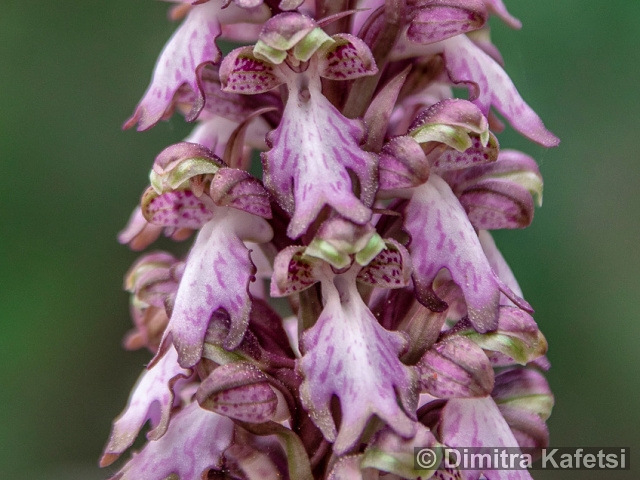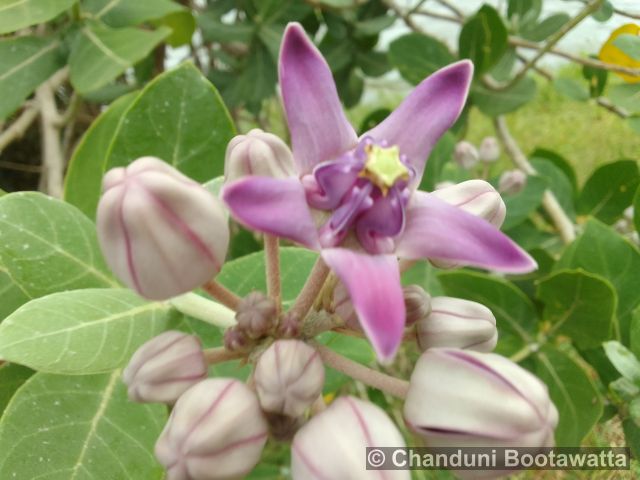Tento příspěvek byl přečten142krát!
YOU CAN FIND THE CZECH VERSION IN THIS LINK
Syn.: Orchis robertiana Loisel., Barlia robertiana (Loisel.) Greuter, Barlia robertiana lusus candida Soó, Himantoglossum robertianum f. candidum (Soó) F.M.Vázquez, Orchis foliosa Masson ex Ker Gawl., Orchis fragrans Ten., Orchis longibracteata var. gallica Lindl., Himantoglossum robertianum f. gallicum (Lindl.) F.M.Vázquez, Orchis longibracteata Biv., Aceras longibracteatum Rchb.f.

Family: Orchidaceae
Description: Himantoglossum robertianum is one of the largest orchid species. Its height can exceed 100 cm, making it easily distinguishable from other orchids. It has a thick stem with large fleshy shiny green leaves arranged in a basal rosette. The inflorescence is dense and near cylindrical, 6–23cm tall, with the number of flowers varying from 25 to 70. The flowers emit an iris-like scent and the color of the petals can be reddish-violet, greenish, or pinkish outside, paler and violet purple inside. Generally there is not a significant variation among individuals but hypochromatic plants are frequent, characterized by a green hood and a white lip with olive-green margins. This orchid species employs a pollination strategy known as food deception. It emits volatile organic compounds to attract pollinators but offers no reward, as it does not contain any nectar. Therefore, the orchid gets pollinated without expending extra energy to produce nectar.
Substitutions: It is closely related to Himantoglossum metlesicsianum, which is only found in the Canary Islands and Tenerife and is endangered.

Ecology: This orchid prefers areas with plenty to medium sunlight and alkaline soils, ranging from dry to moist conditions. It can be found at altitudes up to 1,700 m. Thriving in habitats such as short, nutrient-poor grassland, garrigue, scrub, and open woodland. It is one of the first orchids to bloom, starting very early in December and continuing until May, with its blooming period peaking in March.
General distribution: This is a rare but widespread species found throughout the Mediterranean region. Specifically, it can be observed in Portugal, Morocco, Spain, the Balearic Islands, France, Italy, Sardinia, Corsica, Algeria, Libya, in the former Yugoslavia, the Greek mainland, the Aegean Islands, Crete, Anatolia, and Cyprus. In March 2023, it was recorded in Israel, and in 2022, it was documented growing in Britain, suggesting a potential expansion of its distribution range due to climate change.

Conservation: Like all orchid species it is included under Annex B of the Convention on International Trade in Endangered Species of Wild Fauna and Flora (CITES). However, it is not threatened with extinction and is assessed as Least Concern.

Use: The bulb of the plant is edible and has a high nutritional value when cooked. It is used to produce salep, a drink made from a starchy yellowish-white powder obtained by drying and grinding the tuber into a powder. Salep can also be added to cereals or bread.

Author of text and photos: Dimitra Kafetsi.
Photographed in Mallorca on 19/3/2023.

References
Claessens, J, K, Jacques, (2016). The Pollination of European Orchids. Journal of the Hardy Orchid Society. Vol.13.
Delforge, P, (2006). Orchids of Europe, North Africa and the Middle East.
iNaturalist. Available from https://www.inaturalist.org/taxa/81694-Himantoglossum-robertianum. Accessed 1 March 2024.
Rankou, H, (2011). „Himantoglossum robertianum” IUCN Red List of Threatened Species, 2011: e.T175926A7145415. Accessed 1 March 2024.



 Poslat emailem
Poslat emailem










